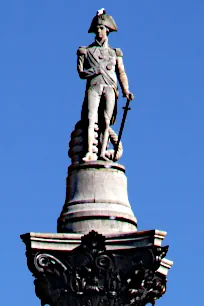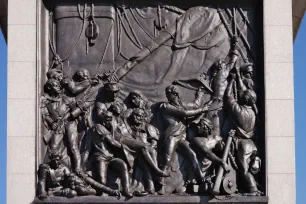In the center of Trafalgar Square stands London’s most famous monument: Nelson’s Column. The monument was built in 1843 as a tribute to Admiral Horatio Lord Nelson, who defeated the French fleet at the Battle of Trafalgar in 1805.


Nelson was fatally wounded during that famous battle off the Spanish coast. His body was transported back to London and buried in the St. Paul’s Cathedral.
Background
In the 1830s, plans for Trafalgar Square, an expansive public square in the heart of the city, started to take shape. In 1838 a committee organized a competition for the design of the crowning piece of the square, a large monument dedicated to Admiral Nelson. A total of 124 entries were submitted, with designs ranging from temples and ship’s prows to monumental statues.
The winning entry was submitted by William Railton, an English architect who up till then was best known for his churches and residential houses. Railton’s proposal called for a 52-meter-tall (170 ft) monument consisting of a soaring Corinthian column topped with a large statue of Horatio Nelson and guarded by four massive lions. The monument’s design was very popular, despite concerns about the visibility of a statue at such a height.
The Monument
Construction of the monument started in 1841 and was completed in 1843 when the sandstone statue of Nelson was placed on top of the column.
The Column
The column itself, constructed of granite from Dartmoor, is about 46 meters in height. The statue of Nelson measures 5.5 meters tall, about three times life-size. The statue rests on an elaborate Corinthian capital which, the story goes, was made from the bronze guns of the Royal George, a large warship that sunk in 1782 while anchored off Portsmouth.
The Statue
The statue is carved from sandstone by Edward Hodges Baily, an English sculptor who had taken part in the competition for the monument. His proposal, a large statue of the admiral, ended up in second place. His design was then chosen for the statue that was to be placed on top of Railton’s column.
The Reliefs


The four bronze bas-relief panels on the sides of the base were added in 1849-1852. They were cast from melted-down guns captured from the French. They glorify Nelson’s naval victories.
The panel facing south shows a dying Nelson aboard his ship the HMS Victory during the Battle of Trafalgar. The other reliefs show scenes from the Battle of the Nile, the Battle of Cape St. Vincent and the Battle of Copenhagen. Each relief was created by a different artist.
The Lions
The four colossal lions at the foot of the monument were added even later. They were created by Edwin Landseer, an English artist who was specialized in the painting of animals. Landseer started working on the sculptures in 1862, and they were unveiled five years later, in 1867. It is said that he used a lion corpse provided by the London Zoo as a model for his sculptures.
- Next: Shard
- More Sights & Attractions in London

